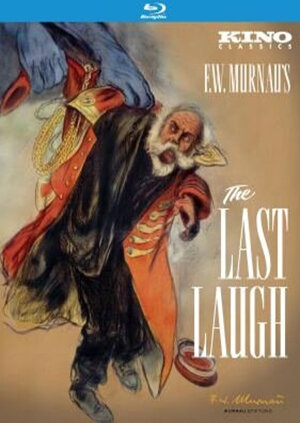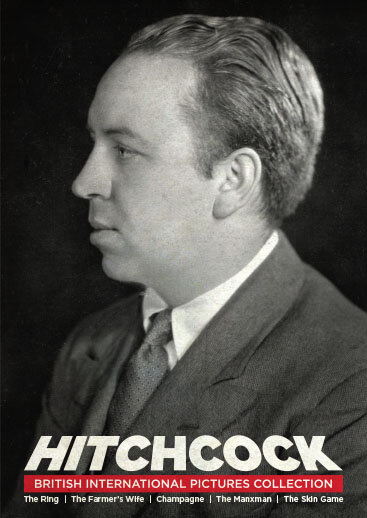GME STREAMLINE: PRESENTING CLASSIC SILENT FILMS BY HITCHCOCK AND MURNAU NOW AVAILABLE FOR DIGITAL SITE LICENSING
/With GME Streamline, we continue to offer key classic films from the Kino Lorber collection, which we are proud to make available exclusively to the North American university market as Digital Site Licenses. We now present the HITCHCOCK: BRITISH INTERNATIONAL PICTURES COLLECTION, as well as F.W. Murnau’s seminal motion picture, THE LAST LAUGH (DET LETZTE MANN). Each of these releases are made available to academic institutions as standalone high resolution digital files , as well as being offered as DVD or Blu-ray bundle packages.
Hitchcock and Murnau’s careers became inexorably linked in the silent era, for when Alfred Hitchcock arrived in Berlin in 1924, F.W. Murnau (PHANTOM, 1922) was filming his masterwork, THE LAST LAUGH. Hitchcock leapt at the chance to watch the great German director at work. Murnau taught Hitchcock the value of painstaking preparation, including meticulous notes and storyboards. Murnau told him that "What you see on the set does not matter…All that matters is what you see on the screen." Hitchcock once remarked that "THE LAST LAUGH was almost the perfect film. It told its story without any subtitles – from beginning to end entirely by the use of imagery, and that had a tremendous influence on me.”
Before he became known as the Master of Suspense in Hollywood, Alfred Hitchcock had already established himself as a precociously talented filmmaker in England. HITCHCOCK: BRITISH INTERNATIONAL PICTURES COLLECTION brings together five features he directed for that production company. Four of them are visually dynamic silent films: the atmospheric boxing drama THE RING (1927), sprightly comedies THE FARMER'S WIFE and CHAMPAGNE (both from 1928), and a love triangle set on the Isle of Man, THE MANXMAN (1929). These lesser-known Hitchcock films were made by the director between the success of THE LODGER (1927), a murder mystery centering around a serial killer, and BLACKMAIL (1929), which was released in both silent and sound versions. Also included in this set is the 1931 sound feature THE SKIN GAME, a melodrama about feuding families.
It was Hitchcock’s time at British International Pictures where he honed his craft, and while most of those films are little known, they are a hugely important part of Hitchcock’s training as a film director. These films represent an artist in the making. He was a director for hire, not necessarily making the films he wanted to and was not given full reign to do as he liked. They do not contain many of the plot elements – suspense, crime, wrong man motifs and McGuffins – that were later associated with his filmmaking practice. Nevertheless, these films demonstrate Hitchcock’s command of the medium: engaging stories, control of his actors’ performances, mastery of framing and mise-en-scène, skillful montage, and the unique visual style that would soon bring him to the attention of Hollywood. Each film has at least a few Hitchcockian flourishes with a signature style he would rely on for the rest of his career. For example, CHAMPAGNE opens with a shot of the dance hall seen through the champagne glass, and in THE MANXMAN, as the close up of a ship’s sail glides by at the beginning of the film, the cinematic canvas opens onto a long shot of boats arriving in the harbor.
After his time at British International Pictures, Hitchcock’s star rose quickly. He made several more films in Britain, including hugely successful films such as THE MAN WHO KNEW TOO MUCH (1934), THE 39 STEPS (1935), and THE LADY VANISHES (1938). In 1939, he signed a contract with David O. Selznick, moved to America and became the beloved Master of Suspense.
◊
In one of the crowning achievements of the German expressionist movement, THE LAST LAUGH (1924), directed by Friedrich Wilhelm Murnau (PHANTOM, 1922), Emil Jannings stars as an aging hotel doorman whose happiness crumbles when he is relieved of the duties and uniform which had for years been the foundation of his happiness and pride. Through Jannings’s colossal performance, THE LAST LAUGH becomes more than the plight of a single doorman, but a mournful dramatization of the frustration and anguish of the universal working class, alongside other realist German films of the Weimar era (1918-1933) such as THE JOYLESS STREET, SLUMS OF BERLIN, CHILDREN OF NO IMPORTANCE, and THE PEOPLE AMONG US. The doorman’s total identification with his job, his position, his uniform and his image helps foreshadow the rise of the Nazi Party; once he puts on his uniform, the doorman is no longer an individual but a loyal instrument of a larger organization.
Shot entirely in the UFA Studio, THE LAST LAUGH is a masterwork of storytelling, utilizing only a single intertitle and relying entirely on Jannings’ expressive acting coupled with extensive use of camera movement. The script was written by Carl Meyer (THE CABINET OF DR. CALIGARI, 1919). The art direction by Walter Röhrig and Robert Herlth imbued largely realist sets with the slightest hints of angularity and distortion to create an uncanny oppressiveness. The city that they birthed on a barren studio backlot is an achievement in scale, verisimilitude and forced perspective, able to take on a suddenly predatory quality in just the right light, with just the right lens. A precursor to the dizzying camera techniques in Marcel L’Herbier’s L’ARGENT (1928), cinematographer Karl Freund’s virtuoso cinematography permeates the entire film. To achieve various effects, Freund placed the camera on a wheelchair, positioned it on top of a bicycle, mounted it on a swing, and strapped it to his chest, at times plumbing cinematic height and depth, attenuating the scale of the buildings and providing forced perspectives; at other times, the dizzying camerawork externalizes the subjective disorientation of the porter. This technique later became known as “entfesselte Kamera” (unchained camera).
Richard Brody, the esteemed film critic of the New Yorker magazine has written that "F. W. Murnau's 1924 drama THE LAST LAUGH (DER LETZTE MANN) may well be the apogee of silent-film production.... The visual clarity of the new [DVD] release reveals the extraordinary means by which Murnau united the emotional, political, psychological, and moral domains in his quasi-Biblical yet modern and naturalistic fable."
The domestic success of this film caught the attention of William Fox, who brought both Murnau and Jannings to America, where they continued their separate, but equally impressive filmmaking careers. Jannings won an academy award for his performance in THE LAST COMMAND (1928, directed by Josef Von Sternberg). For the Fox Film Co., Murnau brought his expressionist skills to the making of SUNRISE (1927). After directing FOUR DEVILS (1927, a “lost” film) and CITY GIRL (1928) for Fox, he went to Bora Bora and made TABU: A STORY OF THE SOUTH SEAS (1931), initially together with Robert Flaherty (NANOOK OF THE NORTH). Upon returning to the United States, Murnau, one of the great narrative filmmakers and visual stylists of the silent era, tragically died at age 42 as a result of a car crash, just days before the premiere of his last film.





